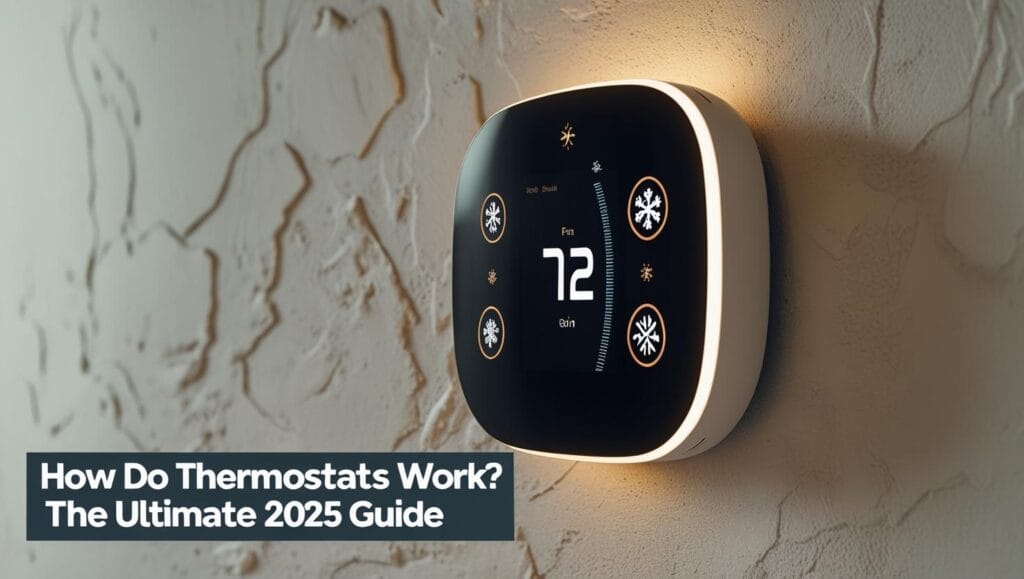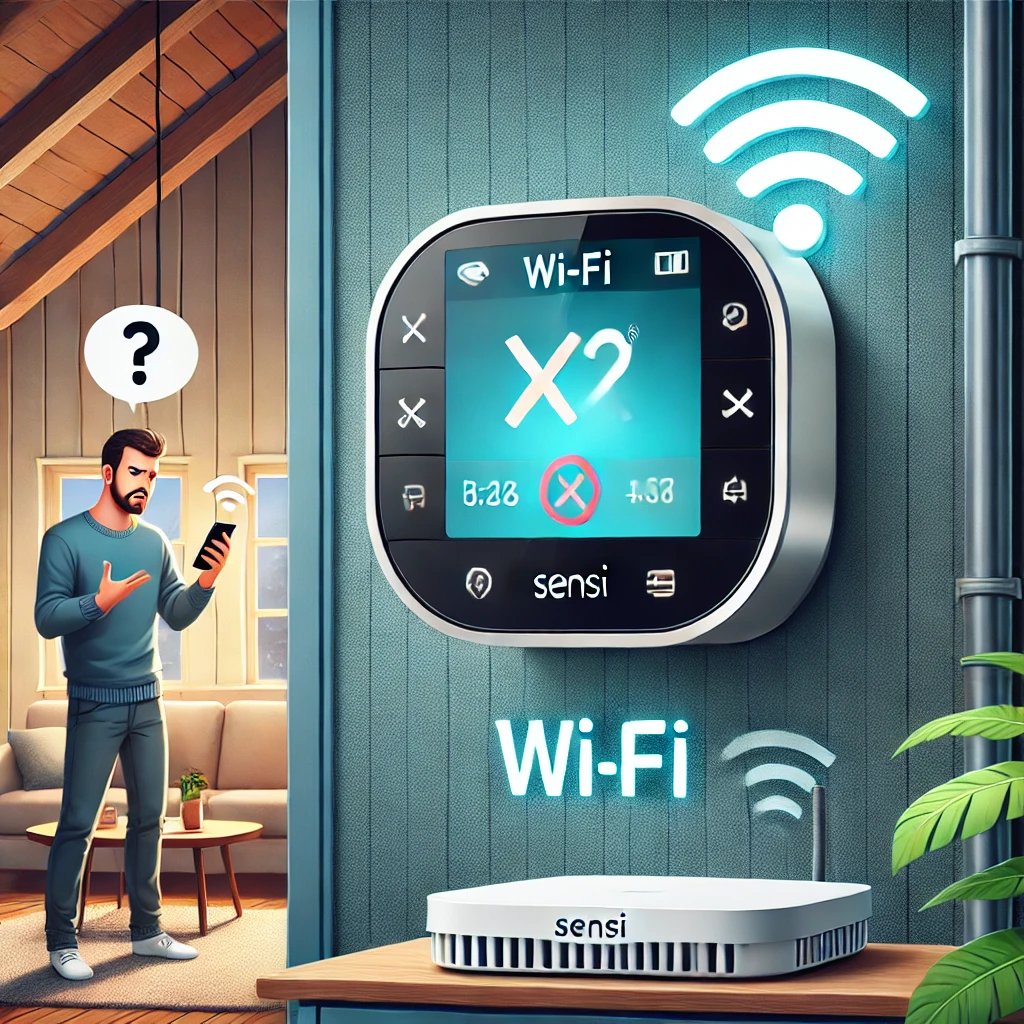How Do Thermostats Work? The Ultimate 2025 Guide
The thermostat is the humble commander of your home’s comfort, but how it works is a mystery to many. In this guide, we’ll demystify everything from how thermostats work in houses to diagnosing when they go bad, and even how they control radiators.
Quick Answers for Homeowners
- How they work: A thermostat senses the air temperature. If it’s colder than your setting, it turns on the heat. If it’s hotter, it turns on the A/C.
- When they go bad: Common signs include a blank screen, the HVAC system not turning on/off, or rapid cycling (short bursts of activity). Often, it’s just dead batteries.
- Radiator control: A central thermostat controls the boiler, while individual Thermostatic Radiator Valves (TRVs) control the water flow to each radiator for room-by-room temperature control.
The Core Principle: How Do Thermostats Work?
At its heart, a thermostat is a switch that responds to temperature. It has one simple job: to compare the current room temperature to your desired temperature (the “setpoint”) and switch your heating or cooling system on or off to bridge that gap.
The Old-School Method: Bimetallic Strips
Older, mechanical thermostats used a clever piece of physics. They contained a bimetallic strip made of two different metals (like steel and copper) bonded together. Since metals expand at different rates when heated, this strip would physically bend as the temperature changed. This bending action would eventually make contact with an electrical switch, turning the furnace or A/C on. When the room reached the desired temperature, the strip would bend back, breaking the contact and shutting the system off.
The Modern Method: Thermistors
Virtually all modern digital and smart thermostats use a component called a thermistor. A thermistor is a resistor whose electrical resistance changes precisely with temperature. A microcontroller inside the thermostat constantly measures this resistance, which tells it the exact room temperature. This digital method is far more accurate, reliable, and faster than the old mechanical strips.
In Practice: How Do Thermostats Work in Houses?
Understanding the basics is one thing, but how do thermostats work in houses to control complex HVAC systems? They serve as the central command center.
Low-voltage wires run from your thermostat to your HVAC control board. When the thermostat “calls for heat” or “calls for cool,” it closes a circuit, sending a signal to the appropriate system. For example:
- Calling for Heat: It signals the furnace or boiler to ignite and the blower fan to distribute warm air.
- Calling for Cool: It signals the air conditioner’s compressor and the air handler’s fan to turn on.
A Special Case: How Do Thermostats Work with Radiators?
This is a common point of confusion. In a home with radiators (a hydronic system), there are often two types of controls working together.
1. The Central Thermostat
The main thermostat on your wall controls the heat source: the boiler. When the central thermostat senses the house is too cold, it tells the boiler to turn on and start pumping hot water through the pipes to all the radiators.
2. How Do Thermostatic Radiator Valves (TRVs) Work?
This is where room-by-room control comes in. The silver or white valve on the side of your radiator is a mini-thermostat itself. This is the TRV. It doesn’t use electricity. Inside the head of the valve is a small capsule filled with a special wax that expands significantly when heated.
- When the room gets warm, the wax in the TRV expands.
- This expansion pushes a pin, which closes a valve inside the pipe.
- This reduces or stops the flow of hot water into that specific radiator, so it cools down.
- As the room cools, the wax contracts, a spring pushes the pin back, the valve opens, and hot water flows in again.
By using a central thermostat to turn the boiler on and TRVs to fine-tune each room, you get an efficient and comfortable heating system.
Troubleshooting: How Do Thermostats Go Bad?
When your home comfort system fails, the thermostat is often a prime suspect. Here’s how thermostats go bad and what to look for:
Common Symptoms of a Failing Thermostat
- HVAC system won’t turn on: The thermostat isn’t sending the signal.
- HVAC system won’t turn off: The thermostat is stuck in the “on” position.
- “Short cycling”: The system turns on and off rapidly.
- Inaccurate temperature readings: The room feels much hotter or colder than the thermostat’s display.
- A blank or unresponsive screen: The unit has no power.
Potential Causes
Before calling for service, check the simple things. The cause is often not a “bad” thermostat, but a simple issue:
- Dead Batteries: This is the #1 cause for blank screens. Replace them first.
- Tripped Breaker: Check your home’s electrical panel.
- Dust and Debris: Open the cover and gently dust the inside with a soft brush.
- Faulty Wiring or Sensor: If the simple fixes don’t work, the unit itself may have failed and needs replacement.
Top Smart Thermostat Recommendations for 2025
Upgrading your thermostat is one of the best ways to save on energy bills. Here are three top-rated smart thermostats available on Amazon US.

Google Nest Learning Thermostat
The iconic smart thermostat. It learns your schedule within a week and programs itself. Its proven energy-saving features and beautiful design make it a top choice for any smart home.
Check Price on Amazon
ecobee Smart Thermostat Premium
Famous for its remote SmartSensors. Place sensors in different rooms (like the bedroom or nursery) to ensure perfect temperatures throughout the house, not just where the thermostat is.
Check Price on Amazon
Amazon Smart Thermostat
An incredibly affordable, Energy Star-certified option. If you already use Alexa, this thermostat offers smart, voice-activated control for a fraction of the price of its competitors.
Check Price on AmazonFrequently Asked Questions (FAQ)
Where is the best place to install a thermostat?
Install it on an interior wall, about 5 feet (1.5m) from the floor, in a central location with good air circulation. Avoid placing it in direct sunlight, near drafts (windows/doors), or above heat sources like vents or electronics, as these will cause inaccurate readings.
Can a bad thermostat cause a high energy bill?
Absolutely. If a thermostat’s sensor is faulty or it’s improperly calibrated, it can cause your HVAC system to run longer than necessary (a phenomenon called “ghost running”), significantly increasing your energy consumption.
How often should you replace a thermostat?
Mechanical thermostats have a lifespan of about 10-15 years. Digital and smart thermostats can last just as long, but technology evolves quickly. Many people choose to upgrade every 5-10 years to take advantage of new energy-saving features.



